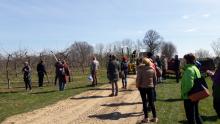What makes a successful demonstration?

It seems to be common knowledge that agricultural demonstrations represent an inherently good support tool for farmers in improving their farming practices. But the question remains on what kind of improvements are these, and what makes one demonstration more successful than others? What unites the two questions is the fact that the impact of a given demonstration largely depends on the way it is being initiated, designed, communicated and implemented, and the other way round – the set-up of a demonstration activity largely depends on the changes it is expected to bring about.
When speaking of the results of a demonstration activity, these can be quite varied depending on their timing and coverage. One pretty straightforward result could be the very fact that a definite number of farmers have been acquainted with some novel equipment or method during the demonstration. Yet, after the event it is up to them whether, how, and when they apply the newly gained knowledge on their own farms. And even further along the road, the given demonstration can lead to a wider spread of a given practice and, for instance, an increased annual productivity levels of local farms. Just to give you an example – a small group of fruit-growers in Latvia learn of new electric pruning shears during a demonstration event. Some of them may decide to purchase and use ones for pruning apple trees on their farms. They may find this new technology to save quite a lot of their time and effort earlier spent on pruning, and, based on their positive practical experience, can advise this further to their other peers.
But, of course, improved productivity is just one, and probably even not the most important, thing that agricultural demonstrations can intentionally or unintentionally contribute to. Along with increased efficiency of production and higher profitability, there are other important possible effects of these demonstrations. For instance, they can enhance farmer’s self-reliance and his/her capacity to adapt to different changes faced by the farm by mastering new skills and gaining access to varied sources of knowledge to tap into when needed. Demonstrations can also help in boosting farmer’s overall quality of life due to applied novel solutions that among other things might allow for improvements in the working conditions on the farm. These innovations can, for instance, lighten farm chores, reduce health risks, and provide some free time for recreation.
You might have seen demonstrations where participants are chatting more among themselves than listening to the demonstrator, or ones where all eyes and ears are directed towards a charismatic leader with no communication among attendants. The first guess might be that the former is a failure, while the latter is a success. But it might as well not necessarily be the case if considering different expected impacts of these encounters. Namely, participation in demonstrations can serve to facilitate communication and learning among peers and thereby strengthen the local community and both formal and informal cooperation.
These are certainly only some of the major impacts demonstrations can bear, with more to be identified and explored through the in-depth studies of a wide range of demonstrations taking place all over Europe. Research to be carried out in the PLAID project will also help to better understand and assess the good practices of demonstration activities. So far, the limited number of available studies on selected agricultural demonstrations have shown that success of a demonstration depends on more than one factor. It is not only about choosing the right topic of key interest to farmers, but also selecting the most appropriate demonstration site for it. Along with properly reaching out to and incentivising both the host and attendants, it is of utmost importance to select the right person to facilitate the demonstration. This said, there is also no way to overestimate the role of the very demonstration process and the learning methods used, be it verbal communication or hands-on activities. The PLAID project has the ambition to enhance and deepen our knowledge of these and other success factors of demonstrations to allow for taking even fuller advantage of this mode of instruction in the future.
Authors: Anda Adamsone-Fiskovica, Talis Tisenkopfs, Mikelis Grivins; Baltic Studies Centre, Latvia



